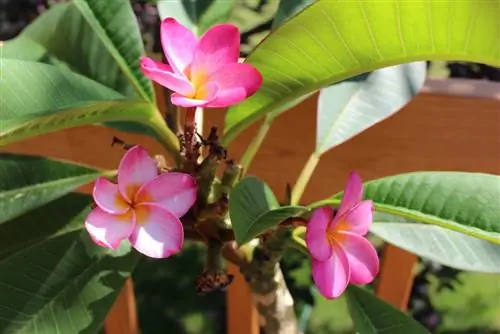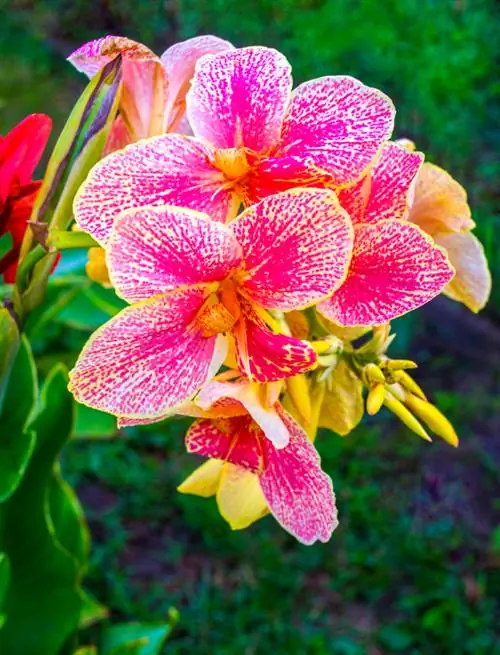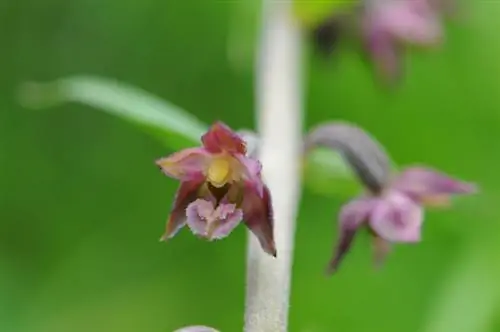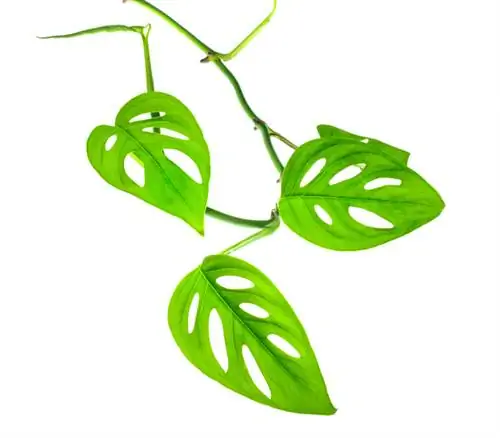- Author admin [email protected].
- Public 2023-12-25 17:45.
- Last modified 2025-06-01 06:02.
The plumeria, also known as frangipani depending on the variety, has long played an outstanding role not only in gardening culture, but also in perfumery. Read below why cultivating them in your local plant oasis is worthwhile.
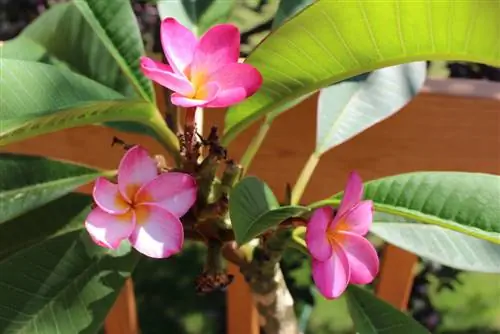
What characterizes plumeria or frangipani plants?
The Plumeria, also known as Frangipani, is a tropical ornamental plant native to Central and South America. It can be grown indoors and is characterized by its large, dark green leaves, showy waxy flowers in various colors and its intense, floral-fruity scent.
Origin
Basically only the types of plumeria known as frangipani play a role in the local houseplant culture. However, the genus includes a few other species (around 20) that are generally native to the Neotropics, i.e. the Central and South American, tropical to subtropical regions from the southern USA to the southern Andes. The distribution area of individual species also extends to the West Indies.
The species relevant to us in Central Europe, the fragrant or red frangipani, are native exclusively to the tropical areas from southern Florida via Mexico to Puerto Rico. Their original habitat is a warm, humid rainforest climate, which is why they only live indoors or outdoors all year round in this country. Greenhouse culture can be maintained.
The Austrians did this in the Imperial Gardens of Vienna at the end of the 18th century. The plant has long been valued in our latitudes as an ornamental and fragrant plant.
Origin at a glance:
- Various species of Plumeria are widespread throughout the Neotropics (southern USA to southern Andes)
- Only the frangipani species from the tropical region of Central America is relevant to local gardening culture
- Can only be kept indoors all year round
Growth
The frangipani grows as a large shrub with a stately, sprawling habit. Other Plumeria species also grow into large, thick-stemmed trees. The Frangipani species can reach around 7 meters in height and 5 meters in width in their native area. In this country, indoor culture usually ends after a maximum of 3 meters.
The richly branched branches have a fleshy, succulent consistency about 2 to 3 centimeters thick. All parts of the plant contain a poisonous milky sap.
Growth characteristics in brief:
- Frangipani cultivated here have a shrub-like, sprawling habit
- In the natural location up to 7 m high and up to 5 m wide, here a maximum height of 3 m
- Other Plumeria species grow as large trees
- Richly branched shrub with fleshy twigs
- Contains poisonous latex
leaves
The leaves of the frangipani are alternate and usually clustered at the ends of the shoots. They have an elliptical to oblong-lanceolate shape and reach a length of 20 to 40 centimeters with a maximum width of 15 centimeters. Their color is a rich dark green. The pronounced, neat veining and the striking midrib give the leaves a stringent appearance.
Leaf properties in keywords:
- Set alternately and clustered at the ends of the shoots
- Elongated, elliptical to obliquely lanceolate shape
- Length 20 to 40 cm, width up to 15 cm
- Rich, dark green color
- Distinctive veining
Flowers
Frangipani flowers have been a popular raw material for perfumery for a long time. The Fragrant Frangipani contains fragrances that are characterized by a creamy subtlety, a gardenia-like florality and a slightly fruity, peach-like nuance. The frangipani odor is used in scented water, especially in combination with other exotic scents such as coconut.
But the visual appearance of the frangipani flowers is also extremely attractive. The sharply contoured shape of their 5 tapered, cup-like petals and their waxy consistency give them a very elegant, exotic character. The magnificent coloring also makes the flower very decorative: there are varieties in bright pink to red or yellow or yellow-creamy white versions.
The petals are fused together in a funnel shape, so that the flowers look like an elegant calyx.
Flower properties at a glance:
- Exceptionally strong, creamy-floral-fruity scent
- Five cup-shaped, waxy petals, fused like a funnel
- Magnificent color variations from pink to red or yellow and white
Flowering time
The frangipani shows its beautiful flowers throughout the summer, between June and September.
Fruit
The flowers each form two follicles that contain many seeds.
Which location is suitable?
In the Location chapter we are again referring to the most cultivated frangipani species in this country, which come from tropical areas. Of course, its original habitat also determines the environmental requirements it requires: like all tropical plants, it needs warmth, brightness and high humidity all year round. It thrives best in a room or greenhouse at a constant temperature of around 20°C.
Unlike other houseplants that come from the tropics, the frangipani doesn't mind direct sunlight. On the contrary, she is a true sun worshiper and wants around 6 hours of sun a day.
You still need to maintain as high a humidity as possible.
In winter, the frangipani takes a forced break due to the dwindling supply of light. It can then be kept a little cooler, but the temperature should not fall below 12°C.
What soil does the plant need?
As a substrate, the frangipani needs moderately nutrient-rich soil with a good drainage layer in the form of sand or expanded clay. Because it reacts quite sensitively to waterlogging. The pH value should be in the rather high range.read more
Watering Plumeria
You should be relatively careful when watering. The frangipani is quite thirsty and needs heavy watering, especially in summer. However, as already mentioned, it is sensitive to waterlogging. So always make sure that the substrate has dried thoroughly before each watering and that the root ball is never left permanently in water. A very regular watering practice is necessary here - not for people who are at home less often.
During the winter rest, however, you should water significantly less so that the plant sprouts properly again in spring and forms buds.
Pouring rules in keywords:
- Water vigorously, especially in summer, but in well-measured portions
- Avoid waterlogging at all costs
- Significantly reduce watering in winter
Fertilize plumeria properly
According to the average nutrient requirements, the frangipani can be regularly supplied with additional food throughout the main vegetation phase. A simple, universal liquid fertilizer that you add to the irrigation water every 2 weeks is suitable for this. However, the dose should only be half concentrated.
Cut plumeria correctly
Depending on how much space you want to give the frangipani or can provide it, it can either be cultivated freely or controlled in shape and size. However, it naturally forms a very shapely, albeit protruding, crown - so if you have space, you should give it space. The interfaces also provide a breeding ground for fungi to settle.
Otherwise, you can easily prune regularly, ideally in early spring. Longer, disruptive shoots can easily be shortened and shaped into the desired shape. The plant then immediately branches again at the interfaces.
Cutting rules in brief:
- Frangipani can, but does not have to be cut
- Because of the naturally beautiful growing crown, only cut if there is a real lack of space
- Otherwise trimming the shoots is possible without any problems
Wintering
The inevitable loss of light in autumn requires hibernation for frangipani cultivation in our latitudes. This means that all other care measures must also be reduced in parallel with the reduced light supply. A slightly cooler ambient temperature makes sense, but it should not fall below around 12°C. To do this, you can place them in a greenhouse that is not too heated. The frangipani should not be deprived of what light it can get, even in the winter months. A glazed roof is therefore advisable.
You can also reduce watering quite a bit. Only give enough water so that the pot ball never dries out completely.
Don't be alarmed: Plumeria loses its leaves during the winter break. This is normal given the lack of light and the generally reduced vegetation. As soon as it gets brighter again in spring, the plant will sprout freshly.
Propagate Plumeria
Frangipani is best propagated via cuttings or by sowing seeds.
Cuttings
With this method, you cut off a 20 cm long shoot from the upper crown of the bush that, if possible, has not yet set any leaves. In order to stop the milky sap flowing out, it makes sense to dry or burnish the interface. Place the cutting in a planter with potting soil and a good proportion of sand. The cutting roots best when the ambient temperature is warm, around 25°C, and evenly moistened. However, you should not put it under foil.
You can also try, after the interface of the cutting has dried well, to let it root in a glass of water.
Seed cultivation
You can also grow a new frangipani from seeds you have collected or purchased. However, there is no guarantee that you will receive a daughter plant of the same variety and color. The seeds are germinated in potting soil at a soil temperature of 20 to 25°C and kept evenly moist. When they reach a size of 5-10 centimeters, the young plants can be repotted and further cultivated in a species-appropriate manner.
Diseases
Fortunately, the frangipani rarely gets sick - care errors that have to do with the water supply are more likely to affect it. This includes, above all, waterlogging, which can lead to root rot, and too low humidity. The latter attracts the usual drought-loving parasites such as spider mites and mealybugs.
Pests
Spider mites and mealybugs are the most common pests that plague moisture-loving tropical plants in heated rooms. It is not easy to maintain sufficient humidity in living spaces. Cultivation in the winter garden is therefore not only recommended for light reasons.
Spider mites
You can easily recognize these pests by the fine webs they create around the leaf axils and branches of their host plant. Especially if they are of a red or yellowish variety, you can see the mites with the naked eye.
Spider mites are quite easy to combat by attacking them with water: first by wiping them with a damp cloth and then spraying the plant thoroughly with the disperser and wrapping it under foil. In this humid, air-poor climate, the mites die within a week.
Mealybugs
Mealybugs also reveal themselves through a clearly visible secretion on the host plant: when they suck on the leaves, they secrete woolly balls, from which they get their name. You should first remove mealybugs mechanically by wiping them with a wet cloth. Then apply a spray treatment with a mixture of water, spirits and soap. (Quantity ratio: 1l - 15ml - 15ml)
Is plumeria poisonous?
As a member of the dogpoison family, frangipani and all other plumeria species are poisonous - they contain a milky sap with toxic saponins in the twigs and leaves. Therefore, it is not necessarily suitable for households with small children and curious pets. Even when cutting the plumeria, it is best to wear gloves.
Varieties
Within the Frangipani species, especially the Red Frangipani, several different cultivars are offered in the plant trade, which differ from each other primarily in the flower colors. Sometimes also a little in growth.
Plumeria rubra Divine
This variety of red frangipani impresses with its particularly pretty and numerous flowers. The waxy, artistic structures appear in a wonderfully exotic play of colors in the summer months: their heart is presented in warm yellow-orange, which turns into clear white on the outside and finally into fresh pink at the edges of the petals. The scent of the P. r. Divine is captivatingly floral and fruity.
In terms of growth, the variety is quite compact due to its intensive branching and is therefore also suitable for exotic plant fans who have less space available. It should be placed in a sunny spot; a winter garden with good humidity is ideal.
Plumeria rubra Gina
In this variety, the flowers in summer are a scarlet pink with pinkish-red and yellowish-white edges that stand out from the medium green foliage. Due to both their slightly more homogeneous coloring and their slightly more plate-shaped opening, they appear somewhat more flat than the flowers of P. r. Divine. Their scent is also very intense.
In terms of growth, it develops quite broadly, but still has compact, richly branched bushes. It grows to a height of around 2-3 m.
Plumeria rubra Inca Gold
The variety name of this variant suggests the color of its flowers: in fact, from June onwards they shine in a rich golden yellow with delicate light yellow edges and therefore exude a warm, southern flair. Its scent is sweet and slightly spicy. In a sunny, warm location the P. r. Inca Gold is also extremely willing to flower.
Its growth is bushy and richly branched, it reaches a height of around 2.50 m.
Plumeria rubra Dulcemia
If you are a fan of strong red tones, we recommend this variant: the more sun it gets, the variety blooms in an intense red. When there is less light, the flower color remains paler, more in the pink to pastel pink range. Its scent is delicately fruity.
The P. r. Dulcemia grows bushy and reaches a height of around 2.50 meters.

